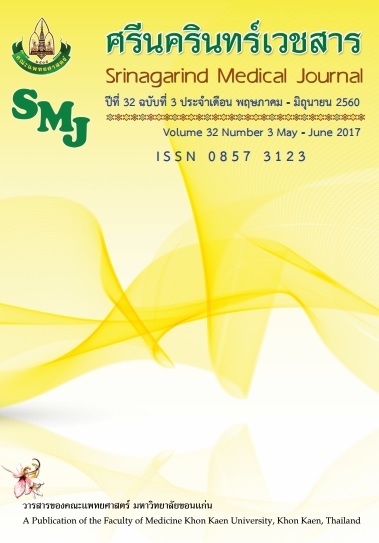Needs in End of Life care of Surgical and Orthopedic patients
Keywords:
Needs of care, End of Life, Palliative care, Surgical and Orthopedic DepartmentAbstract
Background and Objective: Patients with end of life have several complications and psychological problems which impose tasks upon them and caregivers. The study aims to investigate the needs of patients toward end of life care in order to develop palliative care.
Methods: The descriptive study on the needs of caring in terminally ill patients collected in Surgical and Orthopedic Department in 2013 totally 127 cases. Data were collected using record form focusing on five aspects, and analyzed frequency, distribution, and percentage.
Results: The study reveals as follows; 1) Physical aspect – patients need pain management 66.93% ; 2) Psychological aspect – the patients need multiple sustains and supports. They also need good listener. These result in percentage of 34.65 and 32.38, respectively; 3) Social and economic aspect - the patients need to return to their homes, resulting with percentage of 22.05; 4) Information on illness aspect – the patients need participation in decision making, and have advance care planning with their family at percentage of 85.83 and 49.60, respectively; and 5) Spiritual aspect –the patients need support for religious activity or any of their beliefs, with percentage of 23.62
Conclusion: What patients with end of life need in physical aspect is pain management. For psychological aspect, the patients need multiple sustains and supports, return to their homes, participation in decision making, and support for religious activity or any of their beliefs. The results from this research significantly benefit nursing service development in future.
ความต้องการการดูแลของผู้ป่วยระยะสุดท้ายในแผนกการพยาบาลศัลยกรรมและออร์โธปิดิกส์
หลักการและวัตถุประสงค์: ผู้ป่วยระยะสุดท้ายมีปัญหาแทรกซ้อนและอาการต่างๆ ทั้งด้านร่างกายและจิตใจมีความทุกข์ทรมาน ที่เกินความสามารถของผู้ป่วยและญาติในการดูแล ดังนั้นจึงต้องการศึกษาความต้องการการดูแลของผู้ป่วยระยะสุดท้ายเพื่อนำมาพัฒนาการดูแลผู้ป่วยต่อไป
วิธีการศึกษา: ศึกษาเชิงพรรณาความต้องการในการดูแลของผู้ป่วยระยะสุดท้ายของแผนกการพยาบาลศัลยกรรมและออร์โธปิดิกส์ ปี 2556 จำนวน 127 ราย ใช้แบบบันทึกความต้องการการดูแล 5 ด้าน วิเคราะห์โดยแจกแจงความถี่ และร้อยละ
ผลการศึกษา: คือ 1) ด้านร่างกาย พบว่า ต้องช่วยจัดการอาการปวด ร้อยละ 66.93 2) ด้านจิตใจ พบว่า ต้องการการประคับประคองจิตใจหลายอย่างรวมกัน และต้องการให้มีผู้รับฟังระบายความรู้สึกมากที่สุด คิดเป็นร้อยละ 34.65 และ 32.28 3) ด้านสังคมและเศรษฐกิจ พบว่าต้องการกลับไปอยู่บ้านมากที่สุดร้อยละ 22.05 4)ด้านข้อมูลความเจ็บป่วยและการวางแผนการตัดสินใจในการรักษา พบว่า –ต้องการมีส่วนร่วมในการตัดสินใจ และ-ต้องการวางแผนการรักษาล่วงหน้า คิดเป็นร้อยละ 85.83, และ49.60 5)ด้านจิตวิญญาณ พบว่า ต้องการการสนับสนุนให้มีกิจกรรมตามความเชื่อ ร้อยละ23.62
สรุป : ความต้องการการดูแลของผู้ป่วยระยะสุดท้าย คือ ความต้องการด้านร่างกายในการจัดการอาการปวด ด้านจิตใจต้องการให้มีผู้รับฟังการระบายความรู้สึก ต้องการกลับไปอยู่บ้านกับครอบครัว ต้องการมีส่วนร่วมในการตัดสินใจวางแผนการรักษาล่วงหน้า และการสนับสนุนให้มีกิจกรรมตามความเชื่อ ข้อมูลที่ได้จะเป็นประโยชน์ในการพัฒนาระบบบริการต่อไป




